Keeping on top of your pooch’s dental hygiene is a vital part of their overall health and wellbeing, which is why you need to have the best dog toothbrush and toothpaste as part of your grooming kit to help you. Sometimes specific dog toys and food can help aid with cleaning but these aren't a replacement for proper doggy dental care with all the right tools. Regular brushing of your pup’s teeth will keep their gnashers looking squeaky clean without any plaque or tartar buildup while also keeping their notoriously bad doggy breath at bay.
Best dog toothbrush and toothpaste at a glance:
Not looking after your dog’s oral health can have all sorts of implications. Without regular brushing, your dog can be prone to painful gum infections and tooth decay, and if it gets really bad, teeth may also have to be removed. In severe cases, bacteria in the mouth can spread and can cause infections and other conditions to vital organs, such as the heart, liver and kidneys so it’s really important to keep on top of regular teeth brushing.
To help make it easier to engage in a regular dental care routine with your furry friend, we’ve searched the web to find the best dog toothbrushes and toothpastes that come recommended by pet owners online. We’ve also consulted with Emily Norton, the Veterinary Department Manager at Woodgreen Pets Charity, for expert advice on maintaining your dog’s oral health. Take a look at our top picks below…
Best dog toothbrush and toothpaste kit
Best overall dog teeth cleaning kit
 Vet's Best/Amazon
Vet's Best/AmazonWith over 43,000 reviews, this Vet's Best Dental Gel Toothpaste and Toothbrush Kit is much-loved by pets and their owners on Amazon. The toothpaste is packed full of key ingredients, such as enzymes, neem oil, grapefruit seed extract, baking soda and aloe, that will clean away tartar and plaque on your pup's teeth while also giving them a whiter and brighter appearance. Brushing is also made easier as the toothbrush has three bristle heads so you can brush teeth at multiple angles.
Customers say their dogs love the toothpaste but opinions are mixed on the quality of the brush. Some say it broke easily whereas others say it is well made. Something to note is that this brush is pictured with a plastic finger brush, but this isn't included as part of this kit.
Pros
- Cleans teeth while also giving them a whiter and brighter appearance
- Three bristle heads so you can clean at every angle
Cons
- Pictured with a finger brush but this isn't included as part of the kit which customers thought was a bit misleading
Best dog teeth cleaning kit for flavour
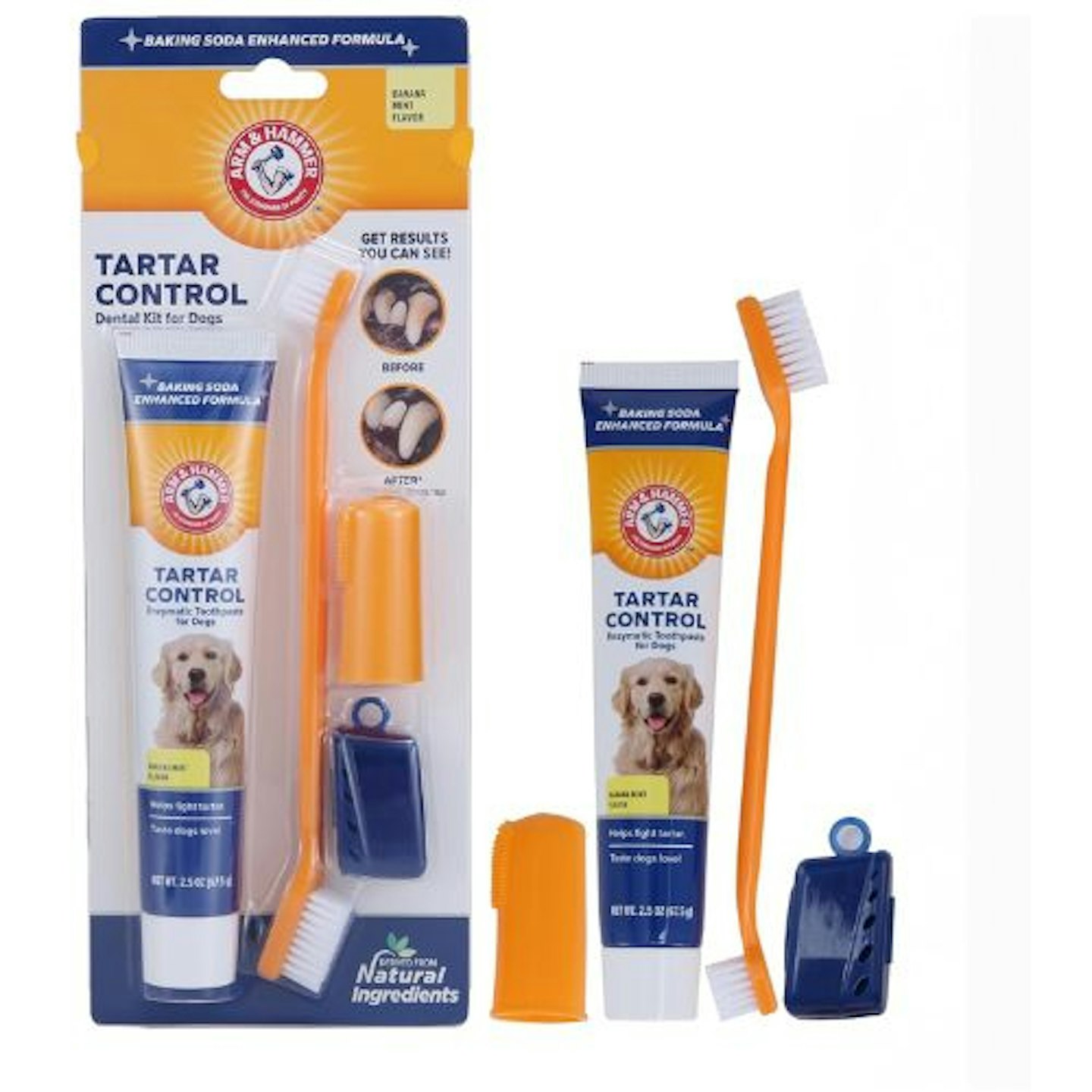 Arm & Hammer
Arm & HammerKeep the doggy breath at bay with the Arm & Hammer Tartar Control Dental Kit. The toothpaste, with its banana mint flavour, does a great job at eliminating bad breath but also helps to reduce tartar buildup and brighten the appearance of your hound's gnashers. The toothbrush is double-ended and it also comes with a finger brush so you can get in all the nooks and crannies of your pup's mouth.
Both canines and their owners highly rate the smell of the toothpaste but reviews mention the brush was smaller than expected so this may not be the best kit for owners with big dogs to use.
Pros
- Nice flavour that's great for eliminating doggy breath
- Toothbrush is double end and it also comes with a finger brush so you can reach all the teeth
Cons
- Toothbrush was smaller than some reviewers were expecting so may not be the best kit to use on big dogs
Best dog teeth cleaning kit for freshness
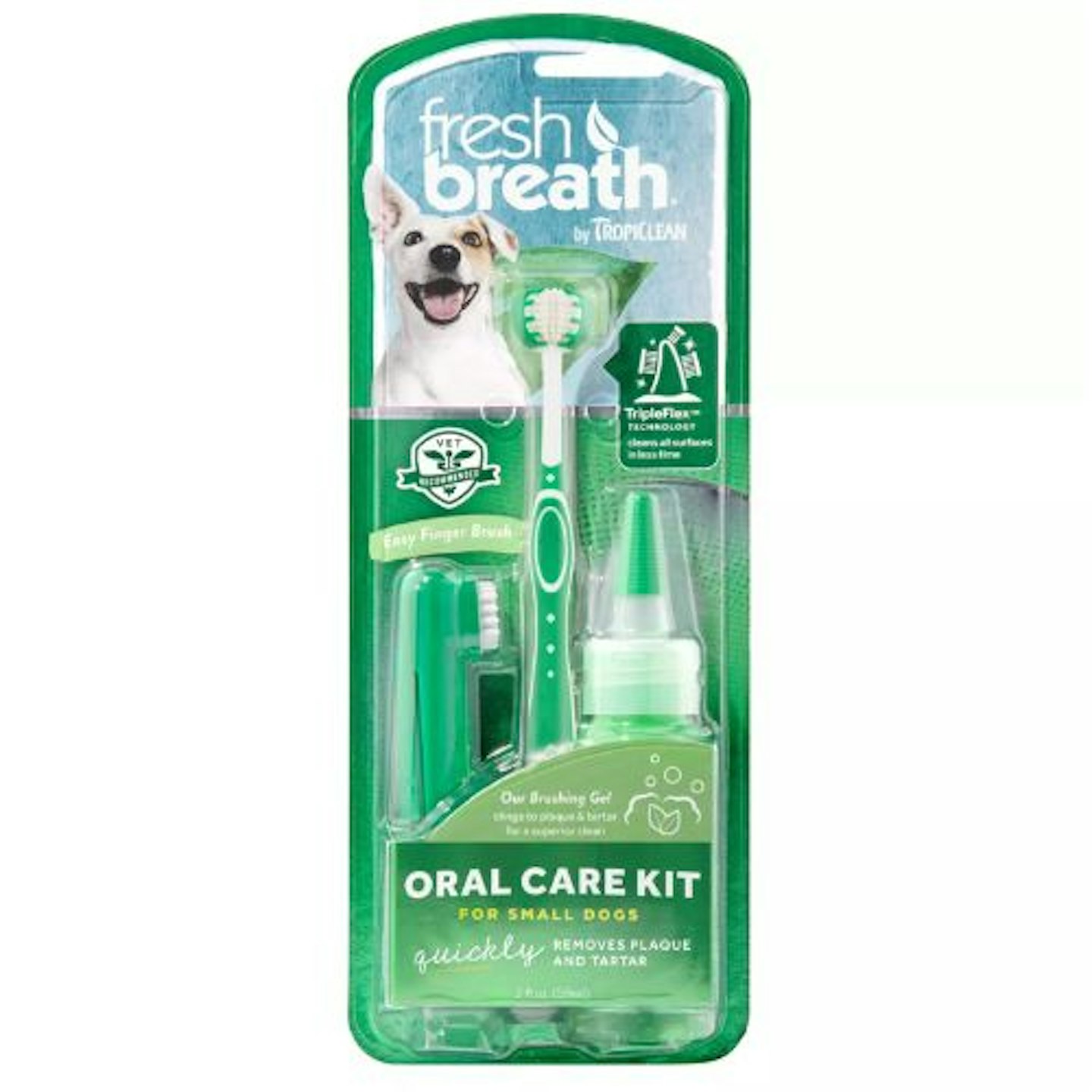 TropiClean
TropiCleanwww.viovet.co.uk
Specially formulated in a dogy-friendly minty flavour, the TropiClean Oral Care Kit will leave your dog's breath smelling fresh. It has been broken to help reduce the appearance of plaque on your pup's teeth by at least 20 per cent so you know it's going some good. It's equipped with a short brush to use on their front teeth and a longer brush to help you get to the trickier-to-reach teeth at the bag of the mouth.
Customers online have found this kit does a great job at keeping their dog's mouth and teeth clean but as the toothpaste is quite minty, some dogs weren't keen on the flavour.
Pros
- Different length brushes included so you can get those tricky spots
- Will help to make your dog's breath fresh
Cons
- Some dogs weren't keen on the minty flavour of the toothpaste
Best for puppies
 Beaphar/Amazon
Beaphar/AmazonBrushing your pup’s teeth will keep their teeth healthy as they grow but by introducing it to them while they’re young will allow them to get used to it more quickly. The brush is just the right size for their small mouths to ensure teeth cleaning is comfortable for your pooch without overwhelming them. The toothpaste is fluoride-free and liver-flavoured, so it’ll entice your puppy to want to eat it so you can get to work with the teeth brushing.
Reviews of this puppy teeth cleaning kit are generally positive with customers rating it highly for its brush size and how easy it is to use. Although there are some comments about how the smell of the toothpaste isn’t that pleasant for humans but the main thing is making sure your puppy likes it and that it is doing the job of keeping their teeth clean.
Pros
- Brush a good size for your pup's mouth
- Liver flavoured to encourage your puppy to put it in their mouth
Cons
- Humans won't like the smell of the toothpaste
Best dog toothbrushes
Best overall dog toothbrush
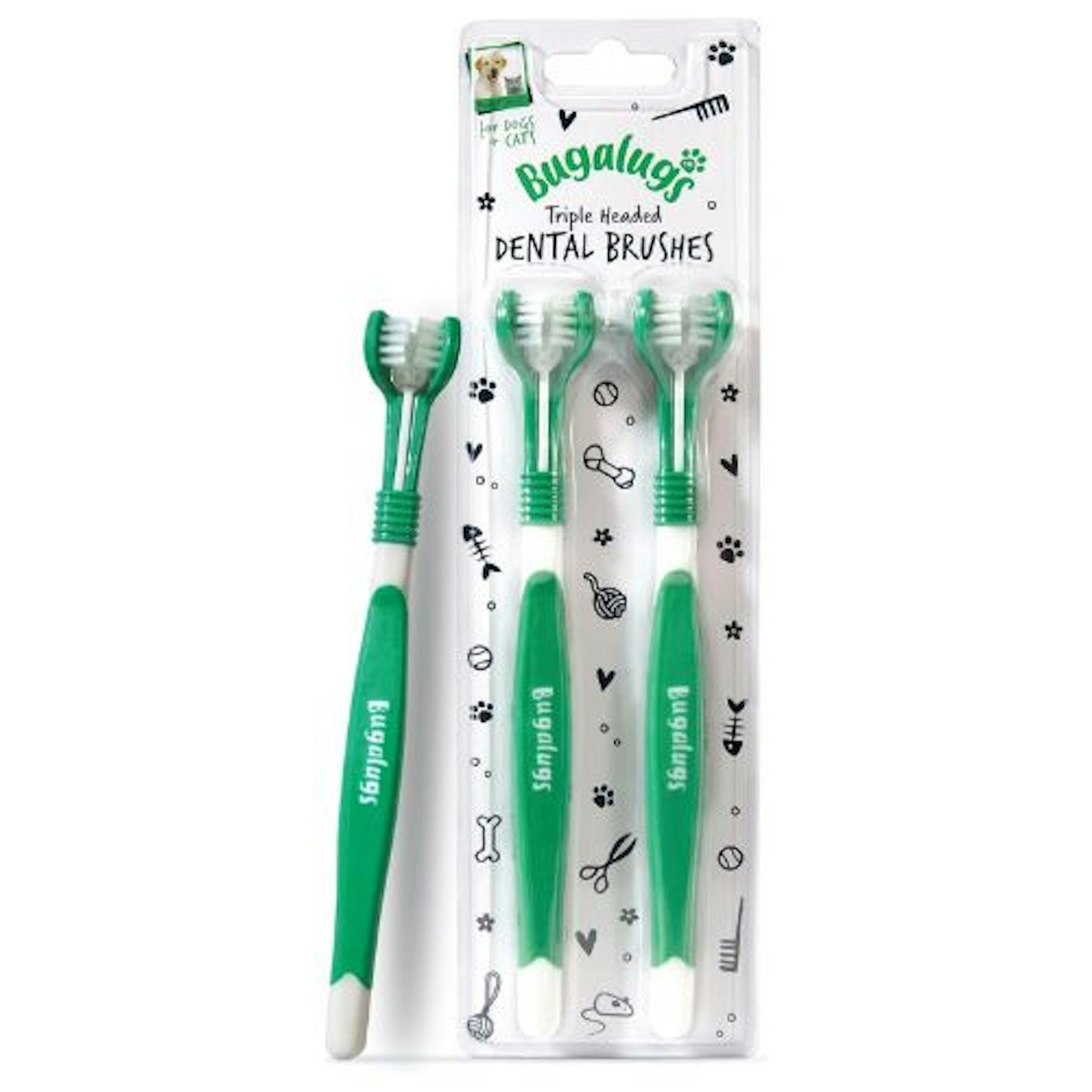 BUGALUGS/Amazon
BUGALUGS/AmazonWith its triple-headed design, the Bugalugs Dog Toothbrush is shaped to clean around each individual tooth to make them squeaky clean and plaque-free from every angle. It’s also designed to do it comfortably as the bristles are soft but firm. The handle is also ergonomically designed with a non-slip handle so you’re in complete control of the brushing experience. You also get two in a pack.
The three-head design makes it easy to clean a dog’s teeth, according to customer reviews with many mentioning it’s made the experience more pleasant for both pooch and owner. There are mixed reviews on the overall quality of the brush, with some saying it’s quite flimsy but others mention the brush seems well-made.
Pros
- Triple-headed design makes it easier to clean around every single tooth
- Ergonomically designed with a non-slip handle for your comfort
Cons
- Some reviewers felt the brush was quite flimsy
Best finger dog toothbrush
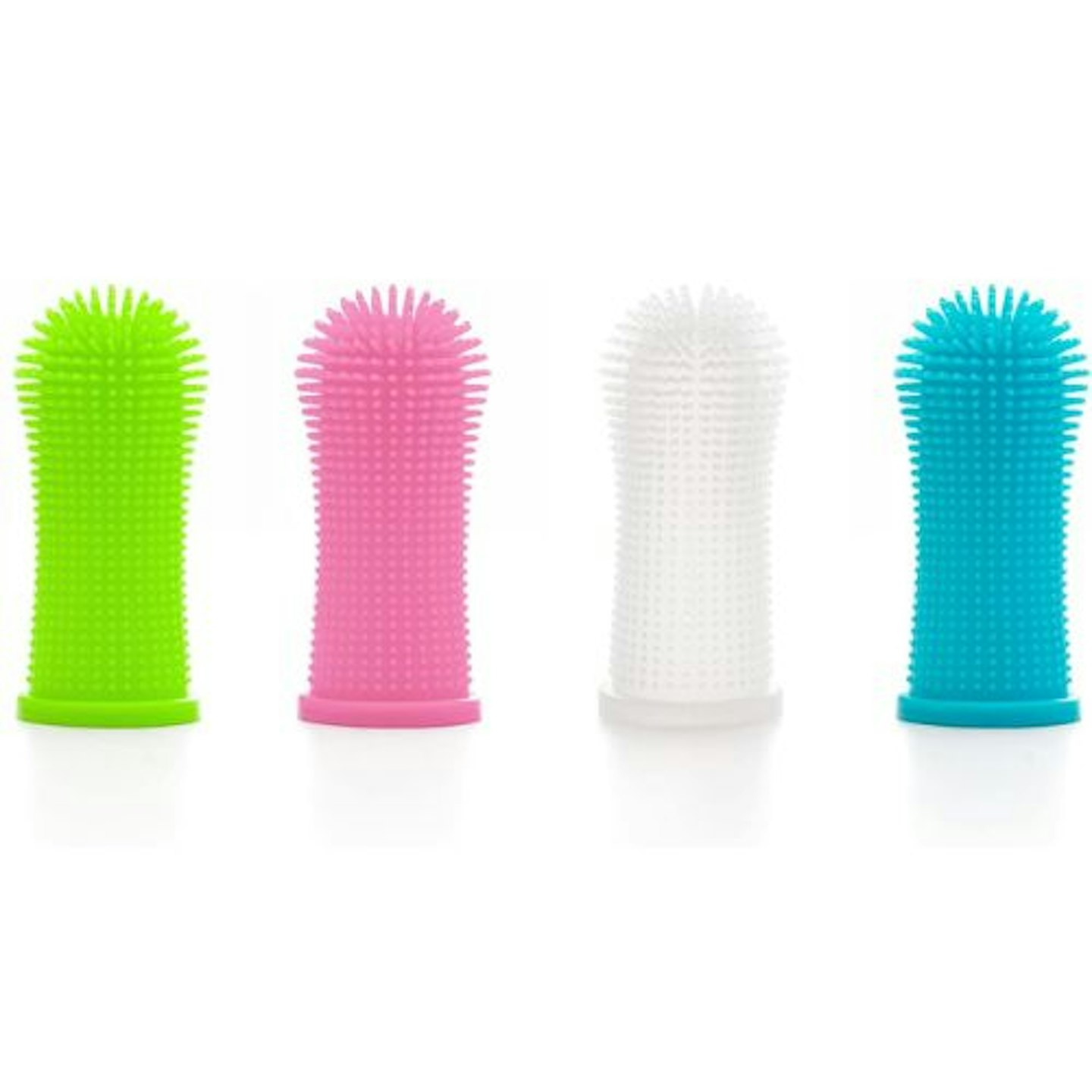 Aujzoo/Amazon
Aujzoo/AmazonGet closer to your dog’s teeth with the Aujzoo Dog Toothbrush Set. Some dogs, understandably, won’t enjoy having a toothbrush shoved in their mouth but they may be more inclined to let you clean them if they realise it’s your finger that’s doing the cleaning. It has silicone bristles all the way around the brush so you can wiggle your finger around your dog’s mouth and clean their teeth as you go.
It goes without saying that by using a brush that covers your finger, you’re at more of a risk of you getting bitten by your dog if they’re not a fan of having something or someone in or near their mouth but considering it does get right into a dog’s mouth, customers have found this four-pack of brushes surprisingly durable. They also like how soft they are and how easy they are to use.
Pros
- Silicone bristles all the way around the brush for a closer, more controlled clean
- Less intimidating to a dog that doesn't like more traditional toothbrushes in their mouth
Cons
- You are more at risk of getting bitten as your finger needs to go directly in your pup's mouth
Best dog toothbrush for coverage
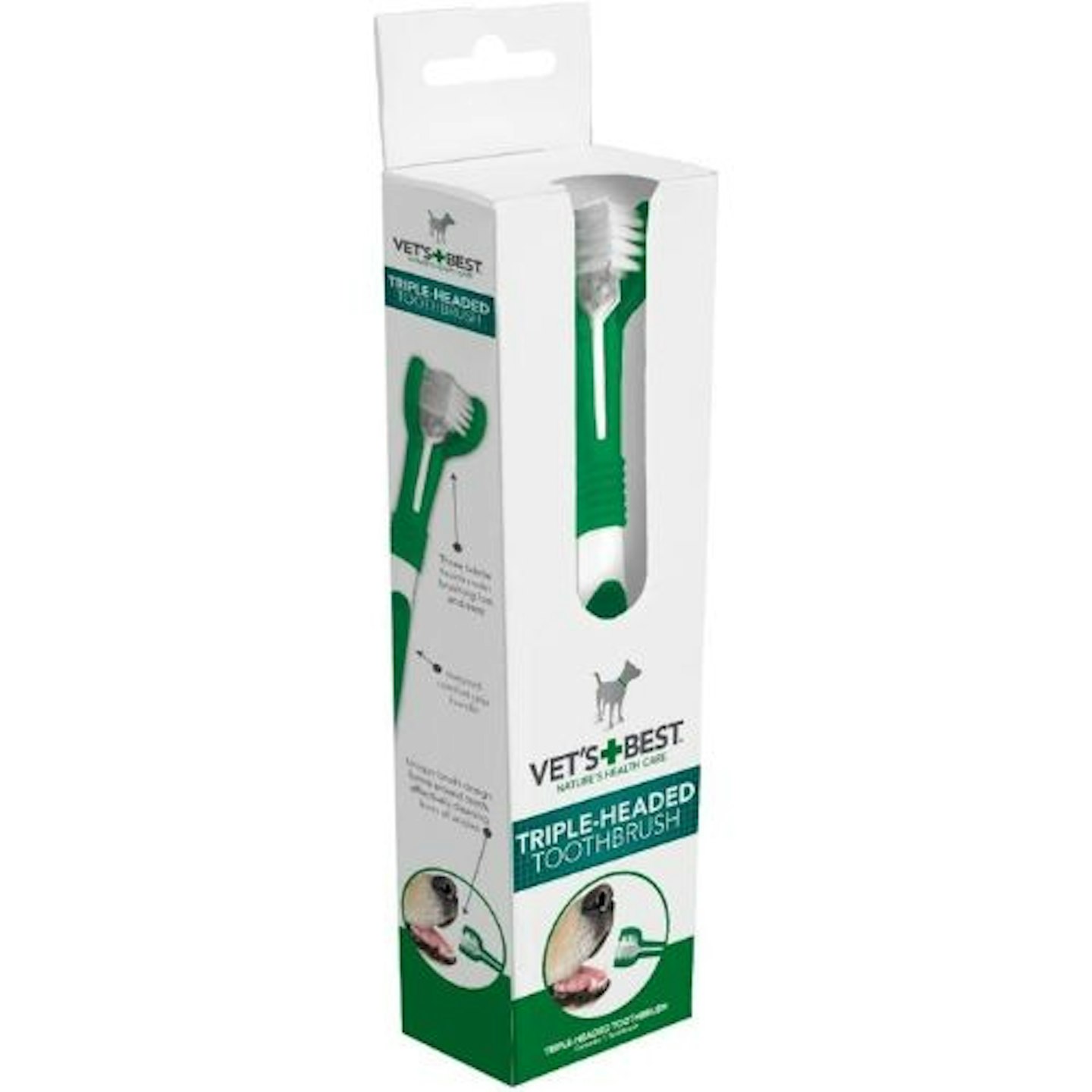 Vet's Best
Vet's Best Clean your pup's teeth from every angle with the Vet's Best Triple Headed Toothbrush. The three brush heads are designed to enclose each individual tooth. Not only does this mean you're cleaning the teeth more precisely but it also means you’ll be able to finish the teeth cleaning session quicker as you’re covering more areas of the teeth at once – music to the ears of your beloved furry bestie. The handle of this brush is textured to offer you a better grip and more control during teeth cleaning sessions.
Customers say this toothbrush is well-made and durable and they like how the triple head means they can brush their pup’s teeth quickly and with precision. Some customers did think the toothbrush was a little chunky so you could struggle with putting it in a small dog’s mouth.
Pros
- Triple head brush for a more precise clean on every tooth
- Covers a large area of teeth at once to make teeth cleaning quicker
Cons
- Some reviewers felt the brush was a little chunky for use on small dogs
Best dog teeth cleaning finger wipes
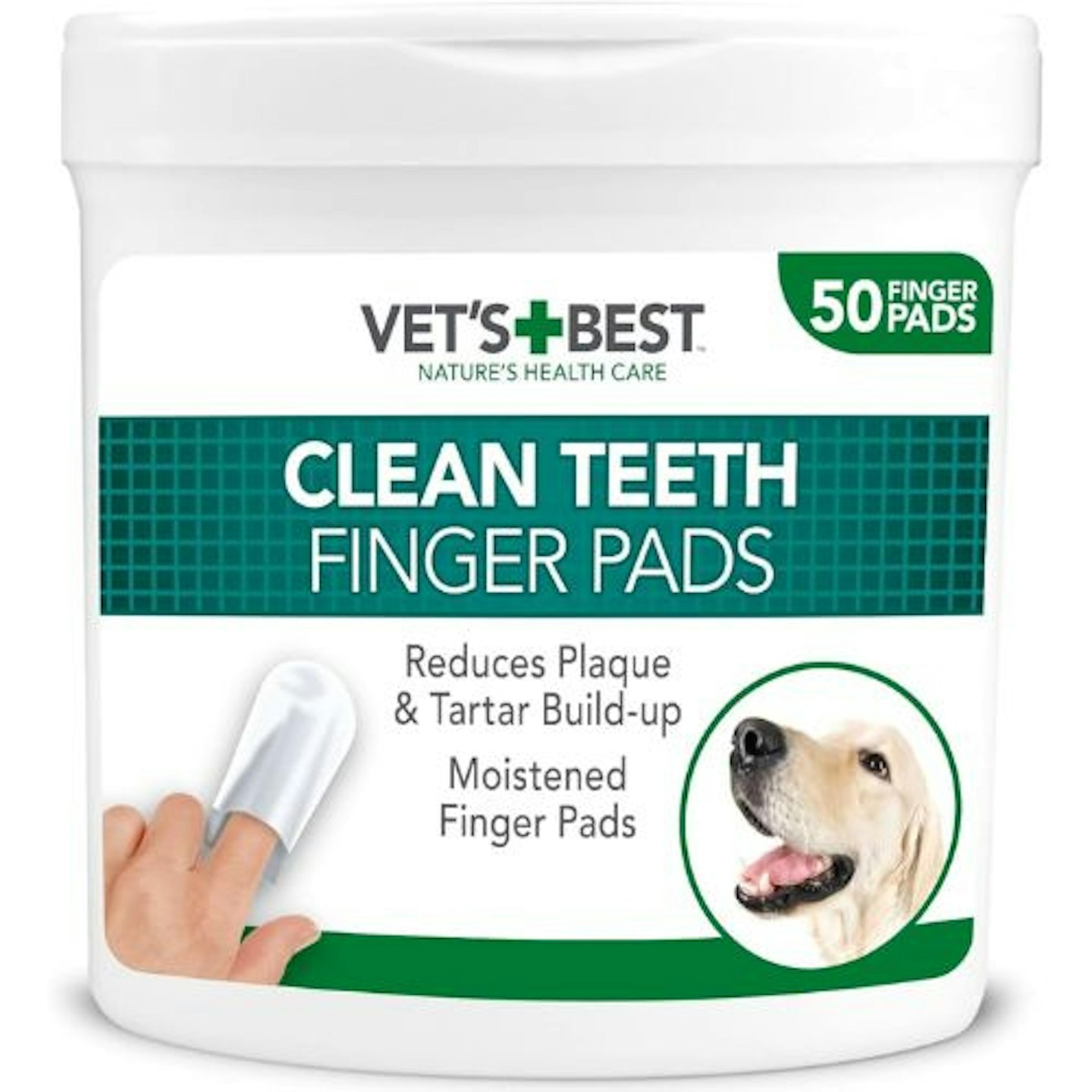 Vet's Best
Vet's BestIf you still want to keep up with your canine companion’s teeth cleaning regime even when you’re travelling or away from home, these Vet's Best Dental Care Finger Wipes are a convenient option. Working in a similar way to the finger brushes we’ve featured earlier in this article, you just pop one on your finger and gently rub between teeth and gums to clean them. It’s already preloaded with product so you don’t need to worry about getting a separate toothpaste so you can simply brush away the nasties while keeping their breath fresh.
The biggest downside to this product is that each finger wipe is designed to be single-use only so you’ll need to get a fresh one out of the packet with every cleaning session. That being said, they are recyclable so not completely non-planet-conscious. Customers say they’re very effective at keeping their dog’s teeth clean and a great choice for dogs that may otherwise be freaked out by a proper doggy toothbrush.
Pros
- Great for travelling and cleaning your pup's teeth away from home
- Preloaded with product so you just pop it on your finger and brush
Cons
- Designed to be a single-use product
Best dog toothpaste
Best liver dog toothpaste
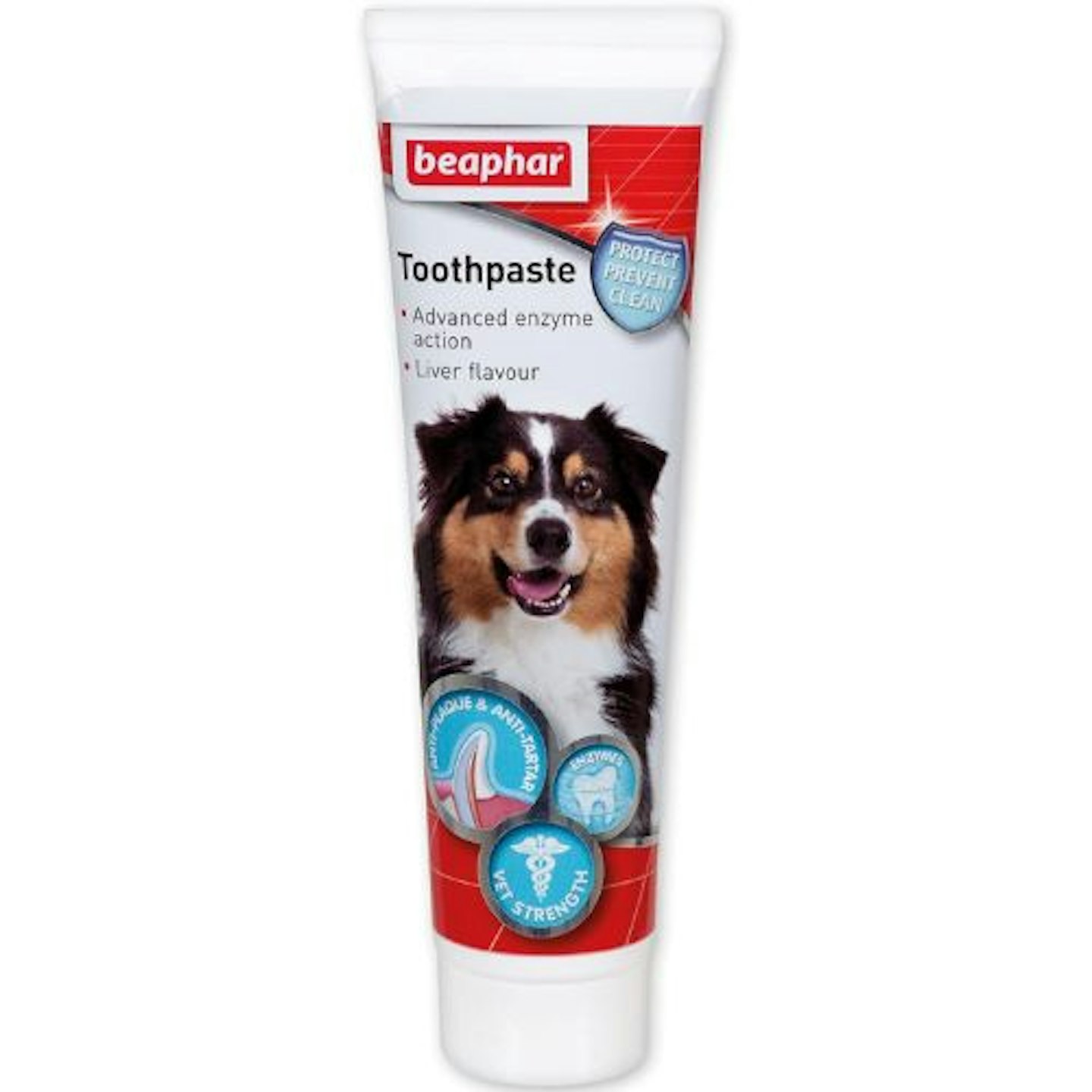 Beaphar/Amazon
Beaphar/AmazonPrevent bad breath while fighting plaque with the Beaphar Advanced Dual-Enzyme Toothpaste. This no-fluoride recipe has two enzymes in its formula that are specifically designed to ward off plaque, bacteria and tartar. It’s flavoured with liver which your pooch will love, but perhaps you not so much!
This doggy toothpaste has over 13,000 reviews, with customers rating it highly for how effective it is at keeping teeth clean while also being great value for money. As we’ve previously mentioned though, many pet owners are not keen on the smell of the flavour.
Pros
- Two enzymes in the formula to fight plaque, bacteria and tartar
- Flavoured with liver which dogs will love
Cons
- Pet owners not keen on the smell of the liver flavour
Best minty dog toothpaste
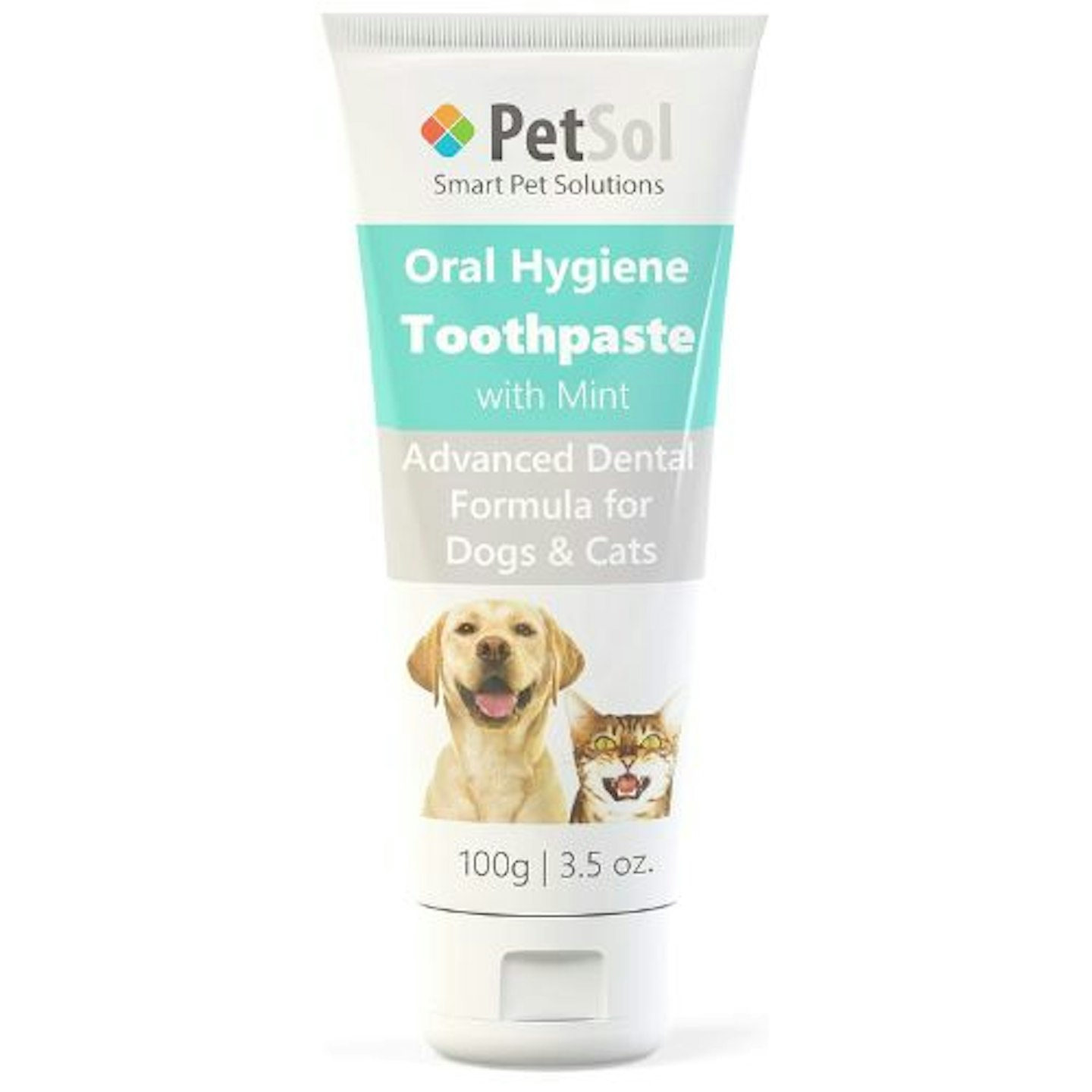 PetSol/Amazon
PetSol/AmazonFreshen up those slobbery doggy kisses with the PetSol Toothpaste. It has a veterinary-approved formula that helps to remove plaque and hard tartar while eliminating odours and bad breath with its minty flavour. It’s best to use a toothbrush or finger brush with this toothpaste, but if your pooch is unsure about it, pop a bit on your finger for them to investigate and they’ll soon realise that you’re giving them a treat rather than toothbrushing being something to be scared and unsure of.
Customers say this toothpaste does a good job of softening the hard plaque and tartar, making it easier to brush off altogether over time. Opinions are mixed on the consistency of the toothpaste, with some saying it was a bit thin and runny which made it harder to use on a toothbrush and others saying it was of a good thickness.
Pros
- Great for freshening up doggy breath
- Customers say it was good for breaking down hard tartar and plaque
Cons
- Some found the consistency to be a bit thin
Best dog tooth cleaning powder
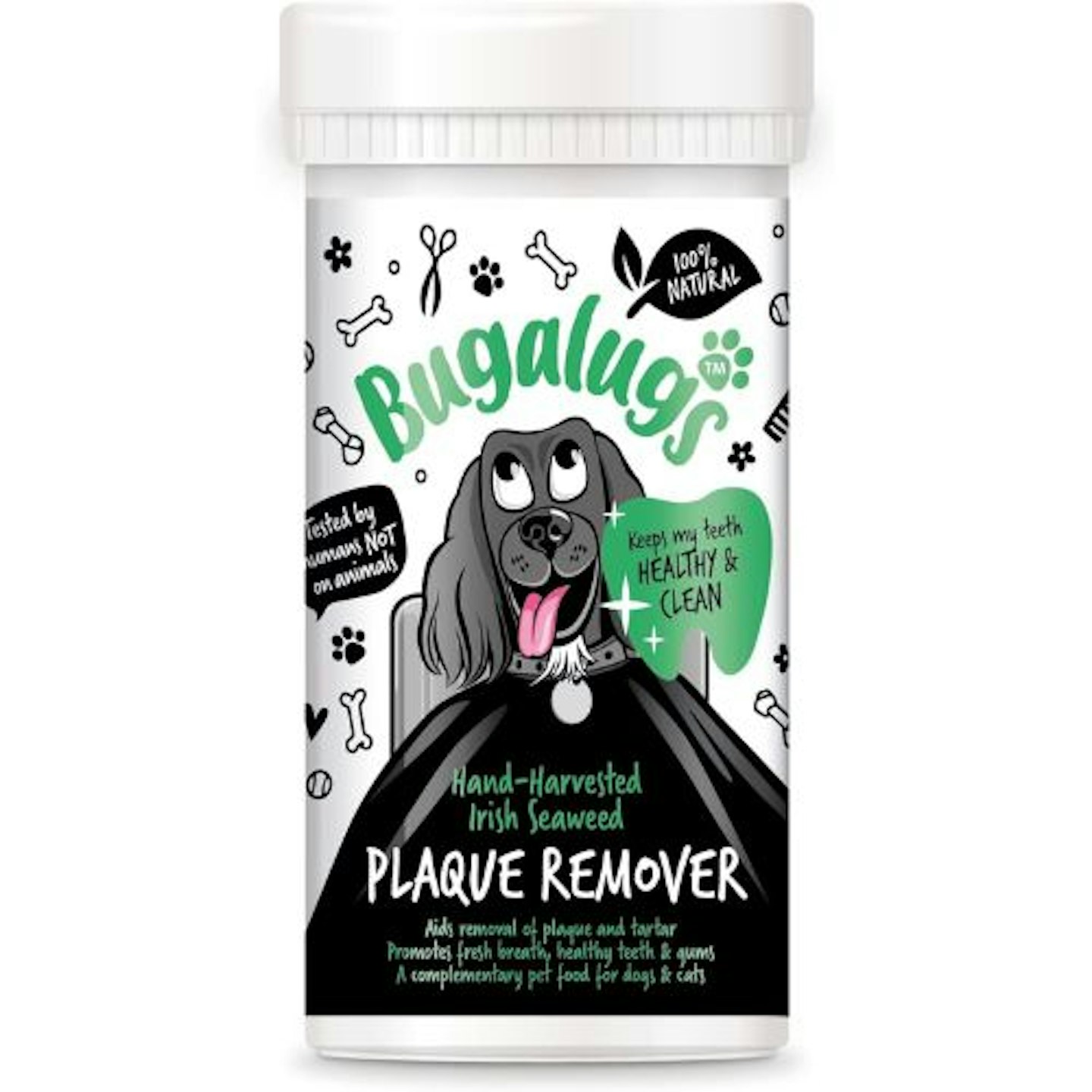 Bugalugs/Amazon
Bugalugs/AmazonSay goodbye to tartar and plaque buildup with the Bugalugs Plaque Off Remover. Made from 100 per cent pure seaweed, this all-natural powder works wonders to keep teeth clean while freshening your furry friend’s bad breath. As well as helping with dental health, the ingredients are also great for supporting a healthy digestion.
This one isn’t a traditional toothpaste as such as it’s designed to be sprinkled on food daily but we’ve still included it as we like the idea that you don’t have to deal with fuss or mess, like you would do with a doggy toothbrush or toothpaste. Not to mention it saves time too. Customers didn’t like the strong earthy smell of this powder but reviews say it’s helped improve the appearance of their dog’s teeth as well as the smell of their dog's breath.
Pros
- Helps with digestive health as well as oral
- Sprinkled on food daily so no need to whip out a toothbrush or toothpaste every time your dog's teeth need a clean
Cons
- Some reviewers found this powder had a strong earthy smell
We put all the frequently asked questions about canine teeth and dental care to Woodgreen Pets Charity Veterinary Department Manager, Emily Norton and here's what she had to say:
FAQs
What do unhealthy dog teeth look like?
Like humans, dogs’ teeth discolour slightly as they age and may develop issues that require veterinary assistance. By brushing your dogs’ teeth and being aware of their oral health, you can ensure their health and welfare needs are met and highlight any problems as you find them.
There are a few dental issues to look out for when checking your dog’s teeth, including:
Gingivitis – reddened, swollen, painful gums, particularly around the gumline where the gum meets the tooth. It’s mostly caused by bacteria but there are other contributing factors.
Calculus – the debris that’s visible on/around the teeth. It can build up and harden over time, damaging the tooth underneath. It can also form over the top of unhealthy teeth, meaning your vet wouldn’t be able to identify the health of the tooth until the calculus is removed.
Fractures – where parts of the teeth have fractured off. Your vet will assess whether the tooth needs removing; if a red dot is visible, the pulp is exposed so the blood supply and nerve endings are unprotected, causing pain for your dog. Tips of teeth can be fractured but not enough to expose the pulp, so your vet may decide that the tooth doesn’t need removing.
Worn down teeth – teeth can be worn down over time from harsh abrasion to the surface of the tooth. This can be caused by chewing inappropriate objects (tennis balls are the worst culprit for this!) or movement of items within the mouth; when dogs carry toys, the swinging movement of the toy, over time, can cause wear on the teeth. Worn-down teeth are no longer as efficient in helping to break down food, meaning your dog may find it tricky to chew some food items.
Discoloured teeth – often caused by trauma to the tooth. A pale pink colour may indicate bruising of the tooth, whereas dark colour tones may suggest the tooth has been irreparably damaged. Your vet will be able to advise further on whether the tooth is still healthy.
Is it safe to brush dog’s teeth with human toothpaste?
Although it would be convenient to share toothpaste, unfortunately, human toothpaste contains an ingredient called fluoride and/or xylitol which is toxic to dogs. However, there are many brands on the market that are pet-specific and contain flavourings more favourable to dogs.
What is the best thing to brush your dog’s teeth with?
When brushing your dog’s teeth, the key things to aim for are cleaning visible debris from around the teeth (calculus) and brushing close to the gum line (not over it, as it’s a delicate area) to remove bacteria that can cause sore, reddened gums (gingivitis).
As tooth brushing can be perceived as quite invasive for your dog, it can take time to train them to be comfortable with it – and to make it safe for you, too! Dogs can have up to 40 teeth and some of those are quite far back in the mouth, so spending time stroking and gently exposing this area of the mouth can help your dog feel more relaxed.
The most successful product to brush your dog’s teeth is a pet finger toothbrush, which allows you full access to your dog’s teeth. They’re designed to sit over a single finger, meaning you’re able to use your other fingers to help expose areas of the mouth. I’d advise using your middle finger to slide just under your dog’s lip line/jowls and using this to expose the area just enough for you to visualise the teeth you’re brushing. Depending on where you’re positioning your dog, it’s advisable to be in front of them rather than behind/on top – as this can be perceived as quite a confrontational stance.
Can you use a human toothbrush on a dog?
Yes! Selecting a toothbrush, such as a human toothbrush, that has a smaller head with softer bristles can be suitable for the sensitivity of dogs’ mouths.
How often should you clean dogs’ teeth?
Unlike humans, the majority of dog food or treats we feed our pooches have minimal ingredients that cause issues for their teeth. However, due to the nature of these products, most dogs do benefit from once-a-week cleaning.
If you have a dog who’s more affected by dental issues, such as gingivitis or calculus, more regular cleaning would benefit them. Smaller dog breeds are more predisposed to dental issues because of the small size of their mouths compared to the number of teeth they have. Sighthounds, particularly greyhounds, are also known to have poor dental health so would also benefit from more regular cleaning.
How can I clean my dog’s teeth naturally?
Dogs’ teeth, like ours, are shaped by diet type. As omnivores, dogs have incisors, canines and molars and these have a specific role to play with food consumption. The diet we feed our dogs is important for their nutritional health, but it’s also just as important for dental health.
Providing chews that allow natural, gentle abrasion to the teeth will not only assist in reducing debris on the teeth, but they also fulfil their natural behaviour of chewing. Many products have been scientifically designed as daily chews that aim to clean your dog’s teeth, specifically the inside of their teeth where it’s difficult for us to reach when brushing. When using these, remember to alter the portion size of your dog’s food to account for the extra amount given in the chews.
When your dog crunches dry dog food/kibble, the biscuits rub against the tooth surface and help clean off debris. If your dog is more prone to dental issues, you could choose a diet that’s specifically designed to help this; the kibble is shaped in a way that requires your dog to chew them for longer, meaning more contact with the tooth surface.
There are also products that can be added to your dog’s water bowl that help to reduce bacteria and debris by making it harder for them to ‘stick’ to teeth. It’s advised, however, that you use these as a preventative when your dog has no dental issues or after they’ve had a veterinary dental procedure, for the optimum effect.
Meet the expert
This article contains expert advice from Emily Norton, Veterinary Department Manager at Woodgreen Pets Charity. Emily has worked in the pet and veterinary industry for over 10 years spanning from research to the charity sector. She’s been part of various studies looking at the prevalence of dental issues in dogs, especially small dog breeds and how the industry can assist owners in this area. She has worked alongside the Veterinary Oral Health Council (VOHC) and completed the British Veterinary Dental Association (BVDA) oral care nurse certificate.
Rosie Floyd is a Senior Home & Pets Product Writer for Yours, specialising in home appliances, décor and furnishings, as well as all things dogs. After completing her Journalism & Media degree from Coventry University back in 2015, she started her career writing about must-visit holiday destinations, moving on to creating content around outdoor living and garden buildings, before joining the team at Bauer.
